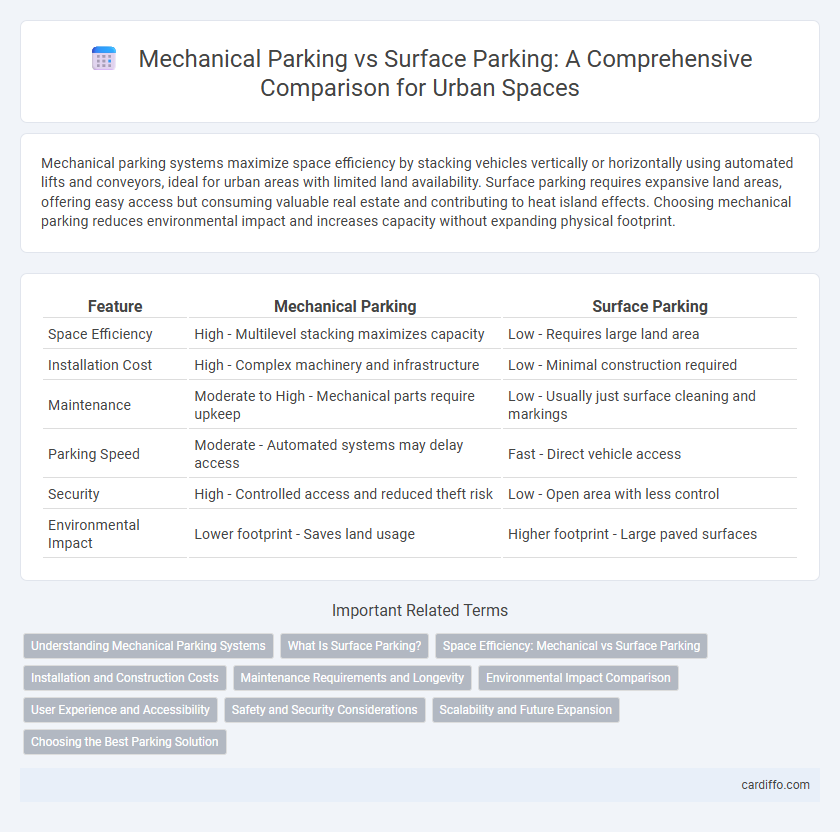Mechanical parking systems maximize space efficiency by stacking vehicles vertically or horizontally using automated lifts and conveyors, ideal for urban areas with limited land availability. Surface parking requires expansive land areas, offering easy access but consuming valuable real estate and contributing to heat island effects. Choosing mechanical parking reduces environmental impact and increases capacity without expanding physical footprint.
Table of Comparison
| Feature | Mechanical Parking | Surface Parking |
|---|---|---|
| Space Efficiency | High - Multilevel stacking maximizes capacity | Low - Requires large land area |
| Installation Cost | High - Complex machinery and infrastructure | Low - Minimal construction required |
| Maintenance | Moderate to High - Mechanical parts require upkeep | Low - Usually just surface cleaning and markings |
| Parking Speed | Moderate - Automated systems may delay access | Fast - Direct vehicle access |
| Security | High - Controlled access and reduced theft risk | Low - Open area with less control |
| Environmental Impact | Lower footprint - Saves land usage | Higher footprint - Large paved surfaces |
Understanding Mechanical Parking Systems
Mechanical parking systems maximize space efficiency by stacking vehicles vertically or rotating them to fit multiple cars in smaller footprints compared to traditional surface parking lots. These automated or semi-automated solutions use lifts, conveyors, or shuttles to move vehicles into designated spots, significantly increasing parking capacity in urban environments. Understanding the mechanics and technology behind these systems helps optimize land use and reduce environmental impact associated with sprawling surface parking.
What Is Surface Parking?
Surface parking refers to open, ground-level parking lots designed for easy vehicle access and exit, typically found in commercial, residential, or urban areas. Unlike mechanical parking systems that use automated lifts or stacks to optimize space, surface parking occupies larger land areas and offers straightforward, non-automated parking solutions. Its simplicity and lower construction costs make surface parking common but less efficient in dense urban environments.
Space Efficiency: Mechanical vs Surface Parking
Mechanical parking systems maximize space efficiency by stacking vehicles vertically and minimizing the footprint required for each car, allowing more vehicles in a limited area compared to surface parking. Surface parking lots consume extensive horizontal space, reducing land availability for other developments and increasing urban sprawl. The compact design of mechanical parking reduces land use costs and enhances capacity in densely populated areas.
Installation and Construction Costs
Mechanical parking systems require higher installation and construction costs due to the complexity of automated machinery, structural reinforcements, and electrical components. Surface parking offers significantly lower upfront expenses, relying mainly on land grading, paving, and simple line marking without the need for advanced technology or substantial structural investment. Budget considerations often favor surface parking for short-term projects, while mechanical parking is justified by space savings in high-value urban areas despite the increased initial outlay.
Maintenance Requirements and Longevity
Mechanical parking systems require specialized maintenance to ensure moving components like lifts and conveyors function smoothly, often extending the system's operational lifespan beyond that of surface parking. Surface parking demands regular upkeep such as resurfacing, repainting lines, and managing drainage, which can lead to higher long-term maintenance costs due to exposure to weather and wear. The longevity of mechanical parking is enhanced by durable materials and automated controls, whereas surface parking longevity is limited by environmental factors and frequent surface repairs.
Environmental Impact Comparison
Mechanical parking systems reduce land use by stacking vehicles vertically, significantly lowering the carbon footprint compared to expansive surface parking lots. Surface parking contributes to increased urban heat islands and stormwater runoff due to large impervious surfaces, exacerbating environmental degradation. Implementing mechanical parking solutions enhances green space preservation and mitigates pollution, aligning with sustainable urban development goals.
User Experience and Accessibility
Mechanical parking systems maximize space efficiency by stacking vehicles vertically, offering enhanced security and protection from weather elements, but may require longer wait times for vehicle retrieval, impacting user convenience. Surface parking provides immediate access and straightforward navigation without mechanical intervention, promoting ease of use and quicker entry and exit, particularly beneficial for individuals with mobility challenges. While mechanical parking often integrates automated payment and reservation systems enhancing user interaction, surface parking's open design supports better accessibility for pedestrians and drivers alike.
Safety and Security Considerations
Mechanical parking systems enhance safety by reducing vehicle theft and vandalism through controlled access and surveillance technologies, unlike surface parking which is more exposed. Enclosed mechanical garages offer protection from environmental hazards and improve pedestrian safety by minimizing interactions between vehicles and pedestrians. Surface parking lots often lack these security measures, increasing the risk of accidents and criminal activity.
Scalability and Future Expansion
Mechanical parking systems offer superior scalability compared to surface parking by maximizing vertical space utilization, allowing for more vehicles in a smaller footprint. These automated structures can be expanded upward or integrated with smart technology for efficient future growth. Surface parking lots, while easier to implement initially, face limitations in land availability and become cost-prohibitive when scaled beyond a certain capacity.
Choosing the Best Parking Solution
Mechanical parking systems maximize space efficiency by stacking vehicles vertically, enabling urban areas to accommodate more cars in limited spaces and reducing land use. Surface parking offers lower installation costs and simpler maintenance but demands extensive land, often leading to inefficient space utilization and increased urban heat. Selecting the best parking solution depends on urban density, budget constraints, and long-term space management goals.
Mechanical Parking vs Surface Parking Infographic

 cardiffo.com
cardiffo.com